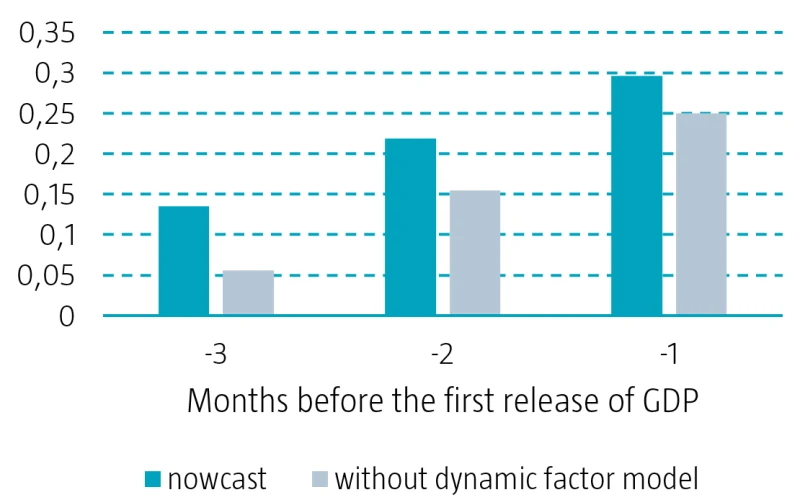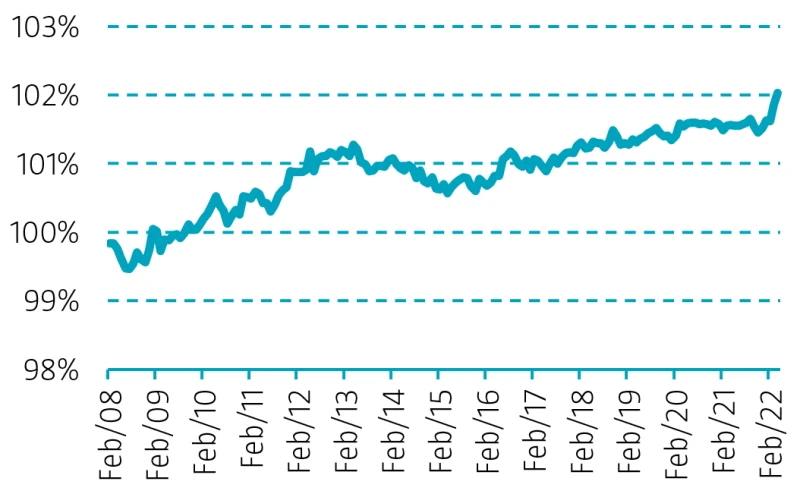Our multi-factor bond strategy uses well-known factors like value, momentum, low risk and quality to select government bonds and credits with superior risk-adjusted returns. The portfolio construction algorithm aims to efficiently harvest these factor premia while keeping the top-down risk profile in line with the index and ensuring a strong sustainability profile.
We now add a quality measure for the selection of government bonds. This measure uses nowcasting to capture timely signals from the plethora of macroeconomic data that are continuously released.1
A quality measure for government bonds
Quality is widely used in equity and credit selection. It favors stocks and bonds of companies with strong fundamental characteristics like profitability. The equivalent characteristics for government bonds are country fundamentals associated with good returns from government bonds. Our research shows that the appropriate factor to consider is the quality of the macroeconomic environment for bond investors. Here, economic growth is one of the relevant fundamentals: bonds from countries with moderate growth are a better-quality investment than bonds from countries with an overheating economy.
Capturing the state of the economy
To select high-quality government bonds we thus want to compare the state of the economy across countries. There are some challenges to gaining timely data on the state of the economy, though.
The official data series for economic growth is GDP, a comprehensive measure of economic activity. The drawback of this series is that, for most markets, it is updated only quarterly, with a publication lag of at least a month. Moreover, the data is prone to substantial revisions. This means that a bond selection process in early July would either use first-quarter data, showing which economies were growing strongly four to six months previously, or would need to be delayed by a few weeks until the publication of the first estimates of second-quarter growth – and maybe even longer as these numbers might be revised later on.
Fortunately, many macroeconomic data series are released more frequently and with a shorter publication lag than GDP. However, these indicators typically relate only to specific parts of the economy. To get the full picture of the overall economy, it is necessary to combine several data series.
For this we use nowcasts, daily estimates of current growth based on a wide variety of data series. In early July, many data series give information about May, and some already for June; survey data can shed some light on what could be expected in July. This is an advantage compared to the traditional GDP numbers: by combining data series that are updated faster and more frequently, one can create a comprehensive measure of activity that leads the latest published GDP data by up to several months.
Capturing growth as quickly as possible
To ensure that the nowcast reflects changes in activity as quickly as possible, one further step is taken. As mentioned, the nowcast combines data from several data series. However, one does not have to wait for all data series to be published. When early data releases point to a slowdown in some parts of the economy, the linkages between different parts of the economy can be used to infer what this likely means for parts of the economy for which data has not been published yet.
A true nowcast uses a model of the relationships between these parts of the economy – a dynamic factor model – to ensure that all information is extracted from a data release: not only the explicit information about that part of the economy, but also the implicit information about related parts of the economy.
Figure 1 | Correlation to GDP-based rankings for nowcast, with and without dynamic factor model, 2008-2022

Source: Robeco
In our Multi-Factor Bonds strategy, we use the nowcast to differentiate between bonds from different countries, based on economic growth in these countries. Figure 1 shows how well we can rank countries based on growth, using the nowcasts available one to three months before the release of the official GDP growth numbers. To show the added value of the dynamic factor model, we compare the nowcast to a similar combination of data releases that doesn’t use a dynamic factor model. The ranking based on the nowcast correlates better with the ranking based on GDP growth than the ranking produced without the dynamic factor model. The ranking produced with the nowcast, three months before the GDP publication, is as accurate as the ranking produced without the dynamic factor model one month later.
Performance
Nowcasting can thus be used to get timely information on the state of the economy. But is this enough to select government bonds with superior risk-adjusted returns? To answer this question, we performed historical backtests. Ideally, we would only use nowcasts that had actually been published at that point in time, but these have a limited history. We therefore extend our dataset by using nowcasts that are carefully reconstructed. As this process requires a large variety of economic indicators, with their exact historical publication dates, there are limits to how far back in time one can go, and the backtest is therefore fairly short.
Figure 2 | Cumulative performance of government bond selection based on nowcast, 2008-2022

Source: Robeco
Figure 2 shows the cumulative performance of a long-short portfolio based on the nowcast. This portfolio has long positions in bonds from countries where growth is moderating and short positions in bonds from countries where the economy is heating up. The portfolio is rebalanced monthly.
We find that the nowcasts generates attractive risk-adjusted returns. Furthermore, this performance is largely uncorrelated with the factors we already use for government bond selection. It thus adds value to our multi-factor government bond selection. Out of prudence, we add this new quality measure with a somewhat lower weight than other measures, to reflect the shorter history over which we can assess its performance. For other factors we have much longer backtests, extending beyond 200 years. For deep-sample evidence on the existence of value, momentum and low-risk factors, please refer to Factor Investing in Sovereign Bond Markets: Deep Sample Evidence.
Conclusion
Bonds from countries experiencing moderate growth are a better-quality investment than bonds from countries with an overheating economy. To select high-quality government bonds, we thus want to capture differences in economic growth. Nowcasting allows us to do so in a timely manner.
Selecting government bonds based on this quality measure generates attractive risk-adjusted returns. Its performance is largely uncorrelated to that of the other factors. It thus adds value to our multi-factor government bond selection.
Footnote
1 This article is based on a more detailed paper by the same authors, entitled “Nowcasting growth: quality in bond selection”, July 2022.
免責聲明
本文由荷宝海外投资基金管理(上海)有限公司(“荷宝上海”)编制, 本文内容仅供参考, 并不构成荷宝上海对任何人的购买或出售任何产品的建议、专业意见、要约、招揽或邀请。本文不应被视为对购买或出售任何投资产品的推荐或采用任何投资策略的建议。本文中的任何内容不得被视为有关法律、税务或投资方面的咨询, 也不表示任何投资或策略适合您的个人情况, 或以其他方式构成对您个人的推荐。 本文中所包含的信息和/或分析系根据荷宝上海所认为的可信渠道而获得的信息准备而成。荷宝上海不就其准确性、正确性、实用性或完整性作出任何陈述, 也不对因使用本文中的信息和/或分析而造成的损失承担任何责任。荷宝上海或其他任何关联机构及其董事、高级管理人员、员工均不对任何人因其依据本文所含信息而造成的任何直接或间接的损失或损害或任何其他后果承担责任或义务。 本文包含一些有关于未来业务、目标、管理纪律或其他方面的前瞻性陈述与预测, 这些陈述含有假设、风险和不确定性, 且是建立在截止到本文编写之日已有的信息之上。基于此, 我们不能保证这些前瞻性情况都会发生, 实际情况可能会与本文中的陈述具有一定的差别。我们不能保证本文中的统计信息在任何特定条件下都是准确、适当和完整的, 亦不能保证这些统计信息以及据以得出这些信息的假设能够反映荷宝上海可能遇到的市场条件或未来表现。本文中的信息是基于当前的市场情况, 这很有可能因随后的市场事件或其他原因而发生变化, 本文内容可能因此未反映最新情况,荷宝上海不负责更新本文, 或对本文中不准确或遗漏之信息进行纠正。

